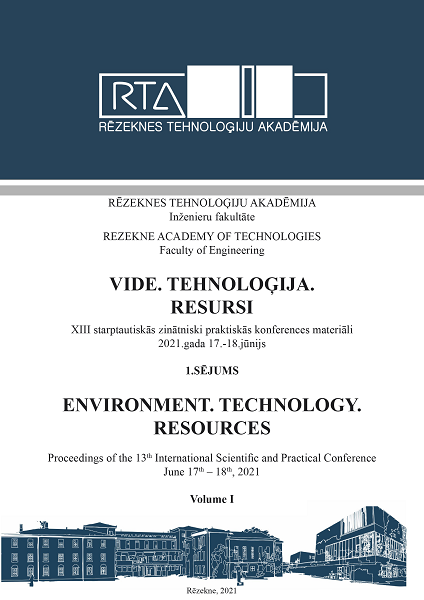NUMBER OF FINE PARTICLES’ AND THEIR MASS CONCENTRATION: COMPARISON OF EMISSION OF NEW PRINTING TECHNOLOGY VERSUS TRADITIONAL LASER TECHNOLOGY
DOI:
https://doi.org/10.17770/etr2021vol1.6558Keywords:
emission, exposure, indoor air quality, laser printer, ink printer, Micro Piezo, particulate matterAbstract
For many years the printers have been essential part of our offices and exposures from various printing technologies have been widely researched. The main objective of this study was to compare emitted number and mass of fine particles from laser printers and new Micro Piezo technology ink jet printers during the printing process and one hour afterwards as these emissions have potential for negative health effects.
Air samples were taken with the particle size spectrometer for real-time ELPI+, Dekati (air flow rate 10 l/min). Measurements were taken ~0.5 m from the printers: one hour before the test, during printing and one hour afterwards. Similar class black&white (b/w) and colour printer of each technology were tested. Each printer performed a 10-page and a 100-page test according to ECMA 328-1 Standard [1].
During laser printer tests from 8324 to 19943 pt/cm3 fine particles were determined on printing phase from b/w and colour printers. Ink jet (Micro Piezo) printers produced less: from 3239 to 5247 pt/cm3. One hour after the printing phase for both types of laser printers’ there were 54722 to 152351 pt/cm3 particles in air and 4270 to 9579 pt/cm3 particles for ink jet printers. Detected particle mass differences was insignificant: in range of 0.002 to 0.012 mg/m³ for laser printers and 0.002 to 0.019 mg/m³ for ink jet printers. Micro Piezo technology printers emitted mass particles were with bigger median size μm.
The highest number of particles was observed one hour after the printing for both tested printer technologies. Laser printers’ emitted 2.5 to 3.8 times more particles in printing phase and 12.8 to 15.9 times more after printing phase. Particle mass in mg/m³ was detected in the size range 6nm - 2.5 μm with no significant mass differences.
Downloads
References
ECMA Inernational “Determination of chemical emission rates from electronic equipment - Part 1 (using-consumables),” 9th edition (December 2018) - Part 1 (using-consumables).
H. Ritchie and M. Roser “Indoor Air Pollution,” revised 2019 [online] Available: https://ourworldindata.org/indoor-air-pollution#annual-deaths-from-indoor-air-pollution-have-declined-globally-by-more-than-1-million-since-1990
J. Sundell “On the history of indoor air quality and health,” Indoor Air, 14 (7), pp. 51–58, 2004.
M. Ścibor, B. Balcerzak, A. Galbarczy, T. Targosz and G. Jasienska. “Are we safe inside? Indoor air quality in relation to outdoor concentration of PM10 and PM2.5 and to characteristics of homes,” Sustainable Cities and Society, 48, 2019. https://doi.org/10.1016/j.scs.2019.101537
Q. Y. Meng, B. J. Turpin, L. Korn, C. P. Weisel, M. Morandi et all “Influence of ambient (outdoor) sources on residential indoor and personal PM2.5 concentrations: Analyses of RIOPA data,” Journal of Exposure Science & Environmental Epidemiology, 15, pp. 17-28, 2005.
A. Cincinelli and T. Martellini “Indoor Air Quality and Health,” International Journal of Environmental Research and Public Health, 14, 2017. https://doi:10.3390/ijerph14111286
A. P. Jones “Indoor air quality and health,” Atmospheric Environment, 33(28), pp. 4535-4564, 1999. https://doi.org/10.1016/S1352-2310(99)00272-1
The WHO European Centre for Environment and Health, “WHO guidelines for indoor air quality: selected pollutants,” 2010.
C. He, L. Morawska and L. Taplin “Particle Emission Characteristics of Office Printers,” Environmental Science & Technology, 41(17), pp. 6039–6045, 2007. https://doi.org/10.1021/es063049z
Z. M. Wang, J. Wagner and S. Wall “Characterization of Laser Printer Nanoparticle and VOC Emissions, Formation Mechanisms, and Strategies to Reduce Airborne Exposures,” Aerosol Science and Technology, 45(9), 2011. https://doi.org/10.1080/02786826.2011.580799
C. He, L. Morawska, H. Wang, R. Jayaratne, P. McGarry et all. “Quantification of the relationship between fuser roller temperature and laser printer emissions,” Journal of Aerosol Science, 41(6), 2010. https://doi.org/10.1016/j.jaerosci.2010.02.015
O. Motonori and T. Tomoaki “Novel Micro Piezo Technology for Ink Jet Printhead,” International Conference on Digital Printing Technologies, pp. 314-318, 2007.
I. Pavlovska, Ž. Martinsone, I. Vanadziņš, I. Mārtiņsone, A. Seile and P. Sudmalis “Occupational exposure parameters for characterization of nanoparticulate matter toxicity: Metal versus wood processing,” Process Safety and Environmental Protection, 102, pp.230-237, 2016. https://doi.org/10.1016/j.psep.2016.03.018
J. G. Jianwei, S. Karrasch, T. Salthammer “Review of the characteristics and possible health effects of particles emitted from laser printing devices,” Indoor Air, 30, pp. 396 – 421, 2020. https://doi.org/10.1111/ina.12646
M. Eglīte “Occupational Medicine,” Riga: Rīga Stradiņš University, 2012.
E.Uhde, C. He, M. Wensing “Characterization of Ultra-fine Particle Emissions from a Laser Printer,” Proceedings of Healthy Buildings, 2006.
T. Tang, J. Hurraß, R. Gminski and V. Mersch-Sundermann “Fine and ultrafine particles emitted from laser printers as indoor air contaminants in German offices,” Environmental Science and Pollution Research, 19(9), 2012. doi:10.1007/s11356-011-0647-5


